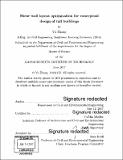| dc.contributor.advisor | Caitlin Mueller. | en_US |
| dc.contributor.author | Zhang, Yu, S.M. Massachusetts Institute of Technology | en_US |
| dc.contributor.other | Massachusetts Institute of Technology. Department of Civil and Environmental Engineering. | en_US |
| dc.date.accessioned | 2017-09-15T15:33:27Z | |
| dc.date.available | 2017-09-15T15:33:27Z | |
| dc.date.copyright | 2017 | en_US |
| dc.date.issued | 2017 | en_US |
| dc.identifier.uri | http://hdl.handle.net/1721.1/111421 | |
| dc.description | Thesis: S.M. in Transportation, Massachusetts Institute of Technology, Department of Civil and Environmental Engineering, 2017. | en_US |
| dc.description | Cataloged from PDF version of thesis. | en_US |
| dc.description | Includes bibliographical references (pages 105-106). | en_US |
| dc.description.abstract | In the design of tall buildings, the lateral system that resists wind and seismic loading usually dominates the structural engineering effort; therefore, optimal lateral system design is important for material efficiency. In a shear-wall-based building, the conventional design process starts with an architect generating a floor plan, which is then passed to a structural engineer, who, based on knowledge and prior experience, tries to place shear walls to balance conflicting requirements: minimum structural weight, satisfactory structural strength and serviceability, conformity to architectural layout. This design process can be slow and inefficient, requiring a trial-and-error approach that is unlikely to lead to the best solution. The work presented in this thesis intends to accelerate the process with an optimization system involving a ground structure program formulation, a modified evolutionary algorithm, and innovative computational techniques. Unlike existing work that focuses either exclusively on structural performance or architectural layout, this research integrates both. An efficient computational design methodology for shear wall layout in plan is introduced. The method minimizes structural weight with constraints on torsion, flexural strength, shear strength, drift, and openings and accessibility. It can be applied from the very beginning of floor plan design or after generating an architectural floor plan. This thesis demonstrates the potential of this approach through a variety of case studies. Key contributions include a novel application of the ground structure method, a fast and robust modified evolutionary algorithm, and a simplified auto-calculation system for reinforced concrete design. | en_US |
| dc.description.statementofresponsibility | by Yu Zhang. | en_US |
| dc.format.extent | 106 pages | en_US |
| dc.language.iso | eng | en_US |
| dc.publisher | Massachusetts Institute of Technology | en_US |
| dc.rights | MIT theses are protected by copyright. They may be viewed, downloaded, or printed from this source but further reproduction or distribution in any format is prohibited without written permission. | en_US |
| dc.rights.uri | http://dspace.mit.edu/handle/1721.1/7582 | en_US |
| dc.subject | Civil and Environmental Engineering. | en_US |
| dc.title | Shear wall layout optimization for conceptual design of tall buildings | en_US |
| dc.type | Thesis | en_US |
| dc.description.degree | S.M. in Transportation | en_US |
| dc.contributor.department | Massachusetts Institute of Technology. Department of Civil and Environmental Engineering | |
| dc.identifier.oclc | 1003292245 | en_US |
